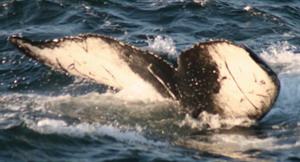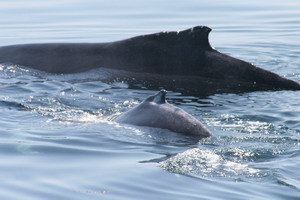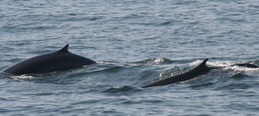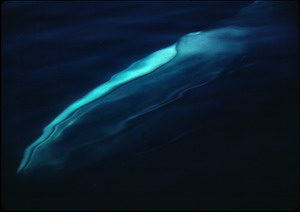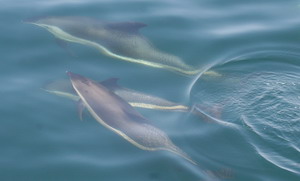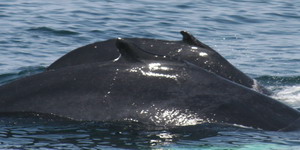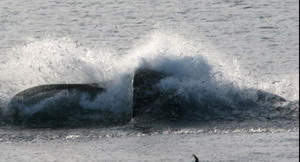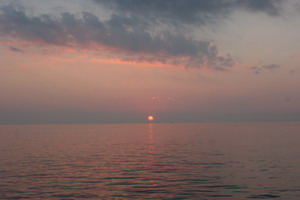DOLPHIN FLEET NATURALIST’S NOTEBOOK 19 TO 25 APRIL 2008
DOLPHIN FLEET NATURALIST’S NOTEBOOK 19 TO 25 APRIL 2008
Saturday 19 April
The morning is bright with light winds as we leave Provincetown Harbor on our first whalewatch of the day. As we slowly move through the harbor and look to Fishermen’s Wharf on our right, a series of photographs entitled “they also faced the sea” stand out against a weathered wooden backdrop. Mounted on a building at the end of the wharf are 5 large black and white photographs of Provincetown women of Portuguese descent, a tribute to the Portuguese community and its fishing heritage. Photographed by Norma Holt, striking images of Almeda Segura, Eva Silva, Mary Jason, Bea Cabral and Frances Raymond represent the women of Provincetown whose families fished the waters off the Cape for over 200 years. They faced the sea in many ways as they kept their culture alive and were the backbone of this vital fishing village. Looking at the photographs, we also are reminded of the artistic culture of the town, the oldest artist community in the United States.
THEY ALSO FACED THE SEA
We round Long Point Light and head North towards Race Point. Along the way we see the small fins of harbor porpoise clearly visible on this calm day. In the currents near Race Point large finback whales move quickly through the water and Northern gannets and terns dive for small fish. Two large humpback whales, Reflection and Glo, slap their tail flukes on the surface- a behavior called kick-feeding- and surface, mouths open through a net of bubbles. Further North, off the edge of Stellwagen Bank, we see more feeding activity. Glo and Blackhole, both large females who had calves last year, are feeding beneath a cloud of birds. Two small humpbacks, not yet identified are feeding in the area as well.
In the afternoon we travel back to the edge of Stellwagen. While we see a few spouts near Race Point, most of the whales are now near the southern edge of Stellwagen Bank. The whales still are actively feeding, blowing clouds and nets of bubbles possibly to entrap the small prey. While a few finback whales are sighted as well as two North Atlantic right whales in the distance, most of the whales are humpback whales. We are able to photograph and identify Anchor, Tulip, Appaloosa and Isthmus (all mature females) and Etchasketch, Swimmer and Entropy.
TULIP
By late afternoon the whales had moved further south. Our first sightings were of finback whales and a small pod of Atlantic white-sided dolphins. Off in the distance we could see the heads of two North Atlantic right whales skim feeding on animal plankton. The humpbacks however were not surface feeding and seemed to be moving about the Bay occasionally lifting their tail flukes in the air. We photographed Syphon’s calf of 2007 but there were several small humpback whales that we did not recognize. Syphon’s calf will be named next spring. Individual humpback whales can be identified readily through photographs of natural markings and scars, particularly those found on the underside of the tail flukes. These patterns, ranging in color from all white to all black, appear to be generally stable in adults, much like our thumbprints. The size and shape of the dorsal fin on the whales’ back, as well as acquired scars also are useful in identifying individual whales.
Scientifically, following individuals of any species throughout their life, is the key to answering basic, biological questions. To date, over 1,800 humpback whales, spanning at least 4 generations, have been documented during 30 years of data collection aboard the Dolphin Fleet. While we do not know how old humpback whales live to be, we do know that they can reach sexual maturity at the age of 4 and have documented each year they return with a calf. The answers to basic questions are necessary to not only better understand the species, but to promote their protection and conservation.
SYPHON 2007 CALF
Sunday 20 April
A bright beautiful day! Morning and afternoon whale watches take us to Stellwagen Bank with a spattering of sightings along the way. While several right whales can be seen far in the Bay well west of our track, we continue to move slowly, acknowledging and willingly complying with the speed restriction of 10 knots due to the presence of right whales. Off the edge of Stellwagen we see several spouts, tails splashes and diving birds. The whales, at least 35 are primarily humpback whales and they are actively feeding. Known individuals include: Tear, Fern, Mars, Springboard, Ganesh, Filament, Tulip, Glyph, Blackhole, Tunguska, Grackle. Etchasketch and two unknown whales. Most likely have returned from a long migration from the breeding grounds in the Caribbean Sea.
Like many whales, humpbacks are international citizens, crossing country borders as they migrate great distances each year. The migration relates to the life cycle of the whale, as they feed during the summer in Northern waters and breed and calve during winter months towards the equator. During the winter, the majority of the population congregates to mate and calve among the reefs and islands of the West Indies. Humpbacks leave the breeding areas in spring to migrate to several high-latitude feeding areas during spring and summer months including the Gulf of Maine, the Gulf of St. Lawrence, Newfoundland-Labrador, Greenland, Iceland, and Norway. Fidelity, or faithfulness, to feeding areas is well documented. While on the tropical breeding grounds, humpbacks from all feeding areas can be seen swimming side-by-side – yet each year, the humpback whales of Cape Cod return to their ancestral feeding grounds- as do their calves once they leave their mothers’ side.
HUMPBACK MOTHER AND CALF
By our sunset whalewatch the whales moved south into the Bay and near Race Point Beach. Our spotter found a group of humpback whales to our west surface feeding. In the midst was a small right whale, rolling on the surface while the humpback whales lunged. With a right whale in their midst, we watched from a distance, eventually moving towards whales near Race Point. Close to the beach finback whales and humpback whales spouted and fed. Here we saw our first mother/calf finback whale of 2008. It is amazing that as large as they are- some 85’ long- that we know so little about them including where they breed. The humpbacks sighted included: Pipette, Glo, Tunguska, Flounder, Lavaliere and Tapioca.
FINBACK MOTHER AND CALF
Monday 21 April
Today the skies are cloudy and gray as we leave the dock. Our spotter finds whales west of Herring Cove in the waters’ of the Bay. Several finback whales and humpback whales as well as a small school of Atlantic white-sided dolphins are sighted. The humpback whales are surface feeding and occasionally we see a finback whale swim by. Its long, sleek body seems to slide through the water with little to no resistance. After a few breaths, the whale arches up and slips beneath the water’s surface. The finback is long, streamlined (called “razorbacks” by whalers) and one of the fastest of all baleen whales. Perhaps due to its slender shape and less blubber, it does not lift its tail when it dives. The finback is second in size only to the giant blue whale and can reach lengths of 85 feet. Its body is light gray to brownish-black on the back and sides. The lower jaw, gray or black on the left side, is bright white on the right side giving the finback whale the distinction of being the only animal divided in half- lengthwise- by color. Swirls of light color arise from the white jaw, giving this elegant whale a marbled appearance. This asymmetrical coloration extends to the whale’s baleen plates as well. The prominent dorsal fin, located 2/3 down its back, is sickle-shaped.
FINBACK RIGHT WHITE LOWER JAW
By late afternoon the Bay seemed full of spouts. We estimated that there were over 40 humpback whales in the area- most of them surface feeding. It was difficult to figure out where to look next. We photographed and identified several humpback whales including: Reflection, Ganesh, Tracer, Appaloosa, Putter, Nile, Blackhole, Tunguska, Flounder, Cygnus, Filament, Fern, Buzzard, Entropy, Thalassa, Reaper, Mars, Rune, Rune’s 2007 calf, Pepper’s 2007 calf, and Mural and her 2008 calf.
Tuesday 22 April
Tuesday dawned hazy with light winds. We made our way to the North west to look for the concentrations of whales we saw the evening before. Close to Provincetown we found a school of 200 to 300 Atlantic white-sided dolphins, the most common toothed whale in the area. Dolphins swim effortlessly beneath the bow and on all sides of the DVIII, surfacing in two’s and threes, much to the delight of all. The pod or school contains several mothers and calves as well as juveniles. The adults generally are 6 to 8 feet long (1.8 to 2.4 meters). They move in perfect synchrony and grace and appear to look at us with their dark eyes as they speed alongside. The captain slows the boat, allowing a clear view of the striking hour glass pattern of beige, white and gray on the dolphins’ side as well as the single blowhole typical of all toothed whales. Like most toothed whales, white-sided dolphins are highly social animals. Most of their activities are carried out within the security of the pod. They work cooperatively and efficiently to herd prey and protect and nurture their young. While little is known about white-sided dolphins, it is believed the pods are comprised of related females and their offspring, both calves and juveniles, and several adult males. Further Northwest are humpback and finback whales actively feeding. We photographed one finback whale and 5 humpback whales: Isthmus, Mars, Filament, Fern and Weave.
ATLANTIC WHITE-SIDED DOLPHINS
The whales moved into the Bay in the afternoon and early evening. In early afternoon there was little surface feeding observed, with the exception of right whales that were skim feeding further south. By late afternoon spouts, splashes and diving birds were everywhere we looked. The first group of humpback whales we spotted included at least 2 mothers and calves: Liner, Tongs, Zebra and their 2008 calves. The calves most likely were born in the warm waters of the Caribbean Sea during the winter. They were able to swim immediately and soon learned to nurse on the fat-rich milk of their mother, gaining about 100 pounds (45.5 kg) per day. In early spring, they began the long migration across the open ocean to the waters off Cape Cod. Fasting in the Caribbean, Tongs, Zebra and Liner need to eat and their calves now have enough blubber for cold water. By now, the calves are about four months old and in a few months will begin to learn how to catch the small fish and shrimp that will sustain them for the rest of their lives. Soon we leave the mothers and calves to watch some of the other feeding humpbacks. We found Swimmer, Tracer, Abrasion, Mars, Fern, Filament, Walrus, Cygnus, Springboard, Pices, Rapier, Reaper, Entropy, Meerkat, Rune and her 2007 calf, Thread, Gumdrop, Reflection and Scratch. It is difficult to leave such an amazing place but we venture back to port with a beautiful sunset to look forward to.
TONGS AND 2008 CALF
Wednesday April 23
Another beautiful day! Today we spend all 3 whale watches in the Bay (and looked at one humpback in the harbor!) where the whales and birds seem to have found a bounty of food. Most spectacular are the Northern gannets. At first we see only splashes and then, hovering birds plunging into the water. Mature gannets are brilliant white with black wing-tips, yellow coloration on their head and blue eyes. Their wing-span is about 6’ although they appear smaller when viewed from our 100’ vessel. Hovering high in the air, the gannets dive dramatically toward the water, folding their wings just before plunging, entering the water like feathered bullets. They can dive up to 30’ depths. The finback whales are circling- a behavior some associated with feeding. Most of the humpbacks appear to be deep diving with few bubble clouds or nets visible on the surface.
During the afternoon, more and more whales appeared in the Bay. By early evening more than 35 humpbacks were actively feeding. As bubble clouds and nets reached the surface, countless numbers of small fish jumped out of the water- only to be fed on by hovering birds. The small fish were American sand lance. Sand lance can reach lengths of six inches (15 cm) and can live to be five years old, an amazing feat considering they are feasted on in all stages of their life, from larvae to adult. Sand lance burrow into loose sand, hence their common, descriptive name. In the sand at the bottom of Stellwagen Bank and areas of Cape Cod Bay, they burrow to escape predation, to rest and to hibernate after spawning. Nearby a large finback whale side-lunged across the surface with it mouth wide-open. It seemed to move in 5th gear- so fast it was difficult to focus our cameras! Humpbacks sighted today: Rapier, Springboard, Walrus, Patchwork, Entropy, Thumper, Drako, Meerkat, Tulip, Buzzard, Fern and several unknowns- hopefully soon to be identified.
FINBACK SIDE LUNGE
Thurday 24 April
Today the sky is bright and clear but the air cool with Northwesterly winds. With the influx of whales and media attention focused on the numbers of right whales near Provincetown, we have another 3 trip day- unheard of in April. As we leave the harbor we notice that the cormorants already are beginning to nest on the breakwater. Double-crested cormorants are amazing marine birds with unusual adaptations. They dive for fish and marine invertebrates from the water’s surface. They have been known to swallow pebbles to help them dive to greater depths. After catching a fish, the cormorant surfaces, flips the fish in the air and swallows it head-first. They do not have well-developed oil glands that produce the waterproofing oil that protects most marine birds. Therefore their feathers are not water-proof so get drenched. Cormorants often drip dry their feathers by perching on the breakwater and stretching out their wings to the wind in a batman pose. They nest in colonies and you easily can see their messy nests of sticks, and twigs dotting the higher rocks. The double-crested cormorant is a little more than two feet long with a wingspan of about four feet. It has dark brown to black feathers, a long hooked bill with an orange throat pouch, a long tail, and webbed black feet. Unlike most birds, males and females look alike. With right whales nearby, our views of the whales in the morning and afternoon are distant but no less spectacular. Right whales skim-feeding, fluking dives and occasional surface feeding by humpbacks makes for a wonderful morning and afternoon whale watch.
DOUBLE-CRESTED CORMORANTS
By late afternoon the right whales were a distance from the finback and humpback whales. Most of the humpback whales were feeding, many surface lunging through bubble nets or clouds. We could see the baleen plates hanging from the whales’ upper jaw and the tiny fringe-like hairs inside. The humpback, Minke and finback whales seen off Cape Cod belong to a group called rorquals- whales with throat pleats. When a rorqual whale finds a large school of small fish or shrimp, it drops its lower jaw, engulfing thousands of gallons of sea water and prey. The throat pleats stretch out like a huge accordion allowing for expansion. With a mouth full of food and water, the whale closes its mouth until only some of the baleen is showing and pushes with its tongue while squeezing the throat pleats together. Water pours out between the individual baleen plates. The inner edge of the baleen is bristly, due to the thousands of overlapping hair-like edges. This forms a fine mesh net or thick mat, sieve or strainer. The prey remains trapped inside the whale’s mouth and is swallowed whole in one gulp. Photographed in the feeding group:Putter, Walrus, Blackhole, Gumdrop, Reflection, Palette, Isthmus and Entropy.
BALEEN!
Friday 25 April
The weather continues to be perfect for a boat ride. We leave the harbor and sight a small humpback whale logging inside Long Point. And in fact, the whale does look like a large log floating on the waters’ surface. Humpback whales do not sleep as we know it. They are air-breathing mammals who spend most of their lives underwater- every breath is a conscious decision. In contrast, we are involuntary breathers and can breathe while we are unconscious. We leave the humpback and continue into the Bay where we find several finback whales and humpback whales and a few Atlantic white-sided dolphins. While the finbacks were moving at a steady pace, most of the humpback whales either were logging or diving for over ten minutes.
In the afternoon a few of the humpback whales were surface feeding. To our south at least 10 right whales were skim feeding, driven forward by the power of their impressive tail flukes. By late afternoon the numbers of whales increased as in previous days- where were they coming from? The spouts of more than 45 humpback whales filled the area west of Wood End Light. Once again we watched the spectacular feeding behaviors- an individual styles- of humpback whales. Our sightings included: Sweep, Ganesh, Pepper, Reflection, Lavaliere, Meerkat, Percussion, Wave, Tulip, Glo, Etchasketch, Grackle, Entropy, Thumper, Rapier and Pices.
BUBBLE NET
On the way back our naturalist emphasizes the importance of remembering the open beauty of the area and the dynamic and fragile web of life it supports. Each day, marine life and the marine environment face a series of threats, each one serious in its own right. While pollution (from chemicals and emissions), ocean noise (from vessels, seismic tests, military sonar), entanglements in fishing gear, ship strikes and whaling pose threats to whales, the cumulative impact of these threats is potentially devastating. Each one of us can make a difference by seemingly small actions: signing petitions, writing letters, cleaning debris from a beach. And together we can work towards maintaining healthy oceans- not only to the benefit of whales and other marine life- but to our own species as well. It is the end of another incredible week on the nearshore waters of Provincetown.








